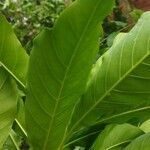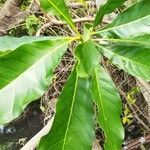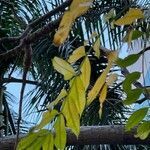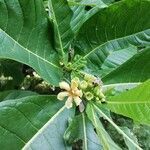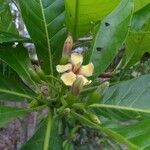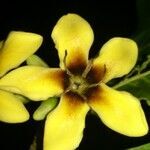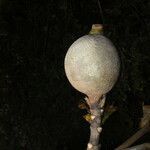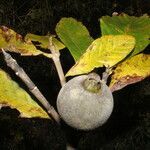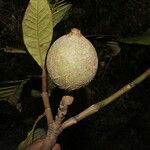Trees 20 m tall, the twigs terete, ultimately angular, the bark smooth, glabrous, the nodes well spaced or crowded terminally. Leaves usually strongly ascending, elliptic, elliptic oblong or obovate oblong, 11-28 cm long, 6-13 cm wide, deltoid or somewhat rounded toward the apex, acuminate, the acumen short, attenuate toward the base, the costa prominulous above, prominent beneath, the lateral veins 11-20, arcuate ascending, thin coriaceous to coriaceous, shiny and glabrous above, often drying black, glabrous to velutinous pubescent beneath, the hairs dense but short; petioles stout, to 1 cm long; stipules free, ovate, to 1.5 cm long, acute, coriaceous to thickly scarious, glabrous to puberulent toward the scarious margins, the margins thickened, pubescent, drawn into a subulate process. Inflo-rescences terminal, cymose, 4-10 cm long or much longer; peduncle short, the bracts ovate, 3-4 mm long, acuminate, the branches to 9, few or many flowered. Flowers to 3.5 cm long, bisexual on pedicels to 1.2 cm long; hypanthium narrowly oblong; calycine cup turgid, ca. 0.6 cm long, stiffly carnose, the margin truncate, the teeth as mere points, glabrous except often with a few hairs marginally; corolla cream white, the tube short cylindrical, ca. 1.5 cm long, 0.8-1.0 cm wide, densely velutinous hairy or villose outside and in, the hairs to 2 mm long, the lobes 5-6, oblong, 1.5-2.5(-3.0) cm long, longer than the tube, widely deltoid at the apex, reflexed at anthesis; anthers 5, subsessile, narrow oblong, 8.0-9.5 mm long, the connective produced for ca. 1.5 mm at the apex, ultimately acute or obtuse, the filaments attached near the mouth; stigmatic lobes 2, narrowly lan-ceolate, erect, ca. 7 mm long, partially exserted. Fruits oblong or subrotund, to 9 cm in diam., glabrous, silvery gray outside, the persistent calyx short, giving a craterlike effect, ca. 1 cm in diam.
More
A medium sized tree. It grows to 10-15 m high. It can be 20 m high. The trunk is 30-80 cm across. The branches come out horizontal. The leaves are opposite. The leaves are near the end of the branches. They are oblong or sword shaped. The leaves are 35-50 cm long by 8-20 cm wide. The flowers are pale yellow with red centres. The fruit grow in clusters. The fruit are large and green. They are round or oval. They are 10-12 cm long by 7-9 cm wide. There are many seeds. They are 8 mm long by 5 mm across.
